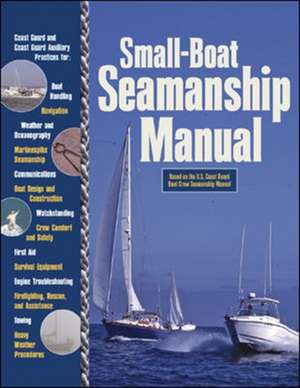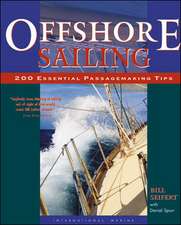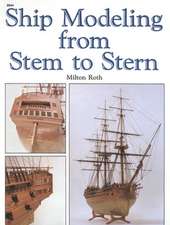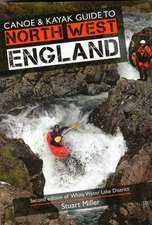Cuprins
Editor’s Introduction
Chapter 1: Boat Crew Duties and Responsibilities
Section A: The Boat Crew
Section B: Boat Crew Duties
Trainee
Crew Member
Boat Engineer
Coxswain
Surfman
Section C: Watchstanding Responsibilities
Lookout Watch
Night Lookout Watch
Helm Watch
Towing Watch
Anchor Watch
Appendix 1-A: Pre-Underway Checklist
Appendix 1-B: Normal Cruising Checklist (Coxswain)/h4>
Appendix 1-C: Auxiliary Pre-Underway ChecklistChapter 2: Patrols
Section A: Safety Patrols
Benefits of Safety Patrols
Auxiliary Safety Patrol Boat Duties
Section B: Regatta Patrols and Marine Parades
Patrolling Regattas
Patrol Boat Assignments
Patrolling the Various Regattas
Marine Parades
Section C: Aids to Navigation Patrols
Section D: Chart Updating Patrols
Section E: Disaster Patrols
Section F: Port Security and Maritime Pollution
Chapter 3: Crew Efficiency Factors
Section A: Physical Fitness Standards
Section B: Crew Fatigue
Section C: Motion Sickness
Section D: Lethal Fumes
Section E: Noise
Section F: Drugs and Alcohol
Section G: Cold Related Factors
Effects of Cold Weather
Hypothermia
Frostbite
Layering Clothing
Section H: Sun and Heat Related Factors
Sun Burns
Dehydration
Heat Rash (Prickly Heat)
Heat Cramps
Heat Exhaustion
Heat Stroke
Susceptibility to Heat Problems
Chapter 4: Team Coordination and Risk Management
Section A: Team Coordination
Team Relationship
Team Coordination and Risk Management
Section B: Team Coordination Standards
Leadership Standard
Mission Analysis Standard
Adaptability and Flexibility Standard
Situation Awareness Standard
Decision-Making Standard
Communication Standard
Assertiveness Standard
Section C: Risk Management Process
Four Rules of Risk Management
Risk Management Process, Step 1
Risk Management Process, Step 2
Risk Management Process, Step 3
Risk Management Process, Steps 4, 5, 6, & 7
Section D: Informal Crew Briefing and Debriefing
Informal Crew Briefing
Informal Crew Debrief
Chapter 5: First Aid
Section A: Crew Member’s Roles
Crew Responsibilities
Handling and Transporting of Injured
Section B: Treatment for Shock
Shock Syndromes
Anaphylactic Shock
Section C: Resuscitation Methods and Emergencies
Resuscitation Procedures
Heart Attack
Stroke
Scuba Incidents
Section D: Treatment for Wounds, Fractures, and Burns
Bandages
Bleeding
Fractures (Broken Bones)
Burns
Section E: Environmental Injuries
Emergencies Caused by Heat
Emergencies Caused by Cold
Hypothermia
Near-Drowning
Fish Bites and Stings
Section F: Miscellaneous Emergencies
Carbon Monoxide Poisoning
Poisoning by Mouth
Eye Injuries
Chapter 6: Survival Equipment and Pyrotechnics
Section A: Personal Flotation Device (PFD)
Type I PFD
Type II PFD
Type III PFD
Type IV PFD
Type V PFD
PFD Storage and Care
PFD Survival Equipment
Standard Navy Preserver
Section B: Hypothermia Protective Clothing
Requirements
Antiexposure Coverall
Dry Suit
Wet Suit
Section C: Headgear
Section D: Boat Crew Signal Kit
Contents
Emergency Signaling Mirror
Signal Whistle
Smoke and Illumination Signal, MK-124 MOD 0
Illumination Signal Kit, MK-79 MOD 0
Distress Signal Light
Section E: Personnel Survival Kit
Section F: Pyrotechnics
Section G: Rescue and Survival Raft
Section H: Emergency Procedures in the Event of Capsizing
Chapter 7: Marlinespike Seamanship
Section A: Types and Characteristics of Line
Line Characteristics
Natural Fiber Line
Synthetic Line
Section B: Inspection, Handling, Maintenance, and Stowage of Line
Inspection
Uncoiling and Unreeling
Maintenance
Stowing Lines
Section C: Breaking Strength and Safe Working Load
Breaking Strength and Safe Working Load of a Line
Breaking Strength and Safe Working Load for Shackles and HooksConsiderations and Limitations
Section D: Knots and Splices
Estimating the Length of a Line
Breaking Strength
Basic Knots
Splices
Whipping
Mousing Hooks and Shackles
Section E: Line Handling and Deck Fittings
Deck Fittings
Line Handling
Appendix 7-A: Estimating the Breaking Strength and Safe Working Load of Lines7-75
Appendix 7-B: Estimating the Safe Working Load of Shackles
Appendix 7-C: Estimating the Safe Working Load of Hooks
Appendix 7-D: Eye Splice in Double Braid Line
Chapter 8: Boat Characteristics
Section A: Boat Nomenclature and Terminology
Section B: Boat Construction
Hull Types
Keel
Principal Boat Parts
Hatches and Doors
Boat Measurements
Displacement
Section C: Watertight Integrity
Closing and Opening Watertight Doors and Hatches
Entering a Closed Compartment After Damage
Section D: General Boat Equipment
Section E: Troubleshooting Basic Mechanical Problems
Troubleshooting Diesel Engines
Troubleshooting Gasoline Inboard Engine (Except Outboards)
Casualties Common to Both Diesel and Gasoline Engines
Troubleshooting the Outboard
Steering Casualty
Basic Engine Maintenance for Auxiliary Facilities
Chapter 9: Stability
Section A: Safety and Risk Management Control
Section B: Understanding Stability
Center of Gravity
Buoyancy
Equilibrium
Types of Stability
Moment and Forces
Section C: Losing Stability
Stability After Damage
Free Surface Effect
Free Communication with the Sea
Effects of Icing
Effects of Downflooding
Effects of Water on Deck
Chapter 10: Boat Handling
Section A: Forces
Environmental Forces
Forces Acting on a Vessel
Shaft, Propeller, and Rudder
Outboard Motors and Stern Drives
Waterjets
Section B: Basic Maneuvering
Learning the Controls
Moving Forward in a Straight Line
Turning the Boat with the Helm
Stopping the Boat
Backing the Vessel
Using Asymmetric or Opposed Propulsion
Changing Vessel Heading Using Asymmetric or Opposed Propulsion
Performing Single-Screw Compound Maneuvering (Single Screw Theory)
Section C: Maneuvering Near Other Objects
Keeping Station
Maneuvering
Section D: Maneuvering to or from a Dock
General Considerations
Basic Maneuvers
Rules of Thumb
Section E: Maneuvering Alongside Another Vessel
Determining Approach
Going Alongside
Section F: Maneuvering in Rough Weather
Using Caution
Negotiating Head Seas
Running Before a Sea
Traversing Beam Seas
Transiting Harbor Entrances, Inlets, or River Entrances
Coping with High Winds
Heaving-To
Section G: Maneuvering in Rivers
Operating in a Narrow Channel
Turning in a Bend
Section H: Anchoring
General Information
Ground Tackle
Fittings
Anchoring Techniques
Anchor Stowage
Chapter 11: Communications
Section A: Radio Signal Characteristics
Modulation and Frequency
Radio Systems
Radio Frequencies
Section B: Prowords and Common Abbreviations
Section C: Verbal Communications
The Phonetic Alphabet
Numbers and Decimal Points
Section D: Radio Operating Procedures
Section E: Communicating Between Coast Guard Facilities
Coast Guard Voice Call Signals and Ops Normal Reports
Bridge-to-Bridge Communications Required
Section F: Emergency Voice Communications and Distress Signals
Standard Voice Radio Urgency Calls
Emergency Position-Indicating Radiobeacon (EPIRB) and Emergency Locator Transmitter (ELT)
Global Marine Distress and Safety System
Distress SignalsSection G: Radio Checks
Chapter 12: Weather and Oceanography
Section A: Weather
Wind
Thunderstorms and Lightning
Fog
Ice
Forecasting
Section B: Oceanography
Waves
Currents
Chapter 13: Aids to Navigation
Section A: U.S. Aids to Navigation System
Lateral and Cardinal Significance
General Characteristics of Short-Range ATONs
Summary of Lateral Significance of Buoys and Beacons
Buoys
Beacons
Section B: U.S. ATON System Variation
Intracoastal Waterway and Western Rivers
Uniform State Waterway Marking System
Section C: Short-Range Electronic Aids
Section D: Radionavigation Systems
Loran-C
Global Positioning System (GPS)
Differential Global Positioning System (DGPS)
Radionavigation System Summary
Section E: The Light List
Chapter 14: Navigation
Section A: The Earth and its Coordinates
Lines and Circles
Parallels
Meridians
Chart Projections
Section B: Nautical Charts
The Compass Rose
Soundings
Basic Chart Information
Scale of the Nautical Chart
Chart Symbols and Abbreviations
Buoy Symbols
Other Chart Symbols
Accuracy of Charts
Section C: Magnetic Compass
Components of a Magnetic Compass
Direction
Compass Error
Variation
Deviation
Compass Adjustment
Applying Compass Error
Section D: Piloting
Basic Piloting Equipment
Distance, Speed, and Time
Fuel Consumption
Terms Used In Piloting
Laying the Course
Dead Reckoning (DR)
Basic Elements of Piloting
Plotting Bearings
Line of Position (LOP)
Set and Drift (Current Sailing)
Radar
Loran
Global Positioning System (GPS)
Differential Global Positioning System (DGPS)
Section E: River Sailing
Major Piloting Differences
Conditions and Effects
Locks and Dams
Safety Considerations Around Navigation Dams
Flood Warnings
Common River Sailing Terms
Chapter 15: Search and Rescue
Section A: Organization and Responsibility
Coast Guard Responsibility
Search and Rescue Coordination
Section B: SAR Emergency Phases
Section C: Legal Aspects and U.S. Coast Guard Policy
SAR Agreements
Distress Beacon Incidents
Flare Incidents
Hoaxes and False Alarms
Maritime SAR Assistance Policy
General Salvage Policy (Other Than Towing)
General Issues
Section D: SAR Incident Information
Initial SAR Information
Additional SAR Information
Section E: Search Planning
Datum
Search Area Description
Search Patterns
Initial Response
Search Area Coverage
Section F: Search Preparations
Section G: Conducting a Search
Chapter 16: Person in the Water Recovery
Section A: Recovery Methods
General Man Overboard Procedures
The Approach
Sailboat Approaches
Approaching in Low Visibility
Approaching Under Surf Conditions
Recovery
Section B: Water Survival Skills
Cold Water Survivability
Survival Techniques
Chapter 17: Towing
Section A: Towing Safety
Assessment and Awareness
Risk Management Planning
Section B: Forces in Towing
Static Forces
Dynamic Forces
Combination of Forces and Shock-Load
Section C: Towing Equipment
Towlines and Accessories
Messengers
Chafing Gear
Deck Fittings and Other Fittings
Drogues
Other Equipment
Section D: Standard Towing Procedures
Pre-Towing Procedures
Towing Astern
Connecting Tow Rig to Fittings
Connecting Tow Rig to a Trailer Eye
Transition to Stern Tow
Underway with Stern Tow
Compensating for Current
Shortening the Tow
Towing Alongside
Sinking Tows
Appendix 17-A: Towing Precautions
Chapter 18: Firefighting, Rescue, and Assistance
Section A: Safety and Damage Control
Coast Guard Firefighting Activities Policy
Safety Assessment and Management Guidelines
Section B: Boat Fire Prevention and Susceptible Areas
Preventive Actions
Susceptible Areas
Section C: Fire Theory, Classifications, and Fuel Sources
Fire TheoryClassifications of Fires and Fuel Sources
Section D: Extinguishing Agents
Section E: Applying Extinguishing Agents
Applying Water
Applying Aqueous Film-Forming Foam (AFFF)
Applying Chemical Agents
Applying Halon
Applying FE-241
Section F: Firefighting Equipment
Fire Hose
Spanner Wrench
Wye-Gate
Tri-Gate
Vari-Nozzle
Fire Monitor
In-Line Proportioner
Mechanical Foam Nozzle
Drop Pump and AFFF
Fire Axe
Carbon Dioxide (CO2) Extinguishers
Dry Chemical Extinguishers (PKP)
Section G: Firefighting Procedures
Coast Guard’s Firefighting Duty
Safety Precautions
Operations
Action
Section H: Extinguishing Fires
Safety Rules
Fire Combat
Firefighting Procedures on Coast Guard Boats
Firefighting Procedures on Auxiliary Boats
Fires Aboard Other Boats
Fire Under Control
Fire Extinguished
Abandoning a Boat
Section I: Dewatering
Action Before Dewatering
Dewatering with an Eductor
Dewatering Using a Drop Pump
Section J: Righting Powerboats and Sailboats
Righting Powerboats
Righting Small Sailboats
Righting Large Sailboats
Section K: Flood Control
Plugging Holes
Patching Holes
Patching Cracks
Chapter 19: Air Operations
Section A: Helicopters and Equipment
HH-65A Dolphin
HH-60J Jayhawk
Other Helicopter Equipment
Section B: Helicopter Rescue Operations
Rescue Swimmer
Helicopter Hoisting Operations
Helicopter Boat Positioning
Delivery of the Rescue Device
Hoisting
Section C: Helicopter Ditching
Section D: Helicopter Salvage and Towing
Section E: Fixed-Wing Aircraft
Appendix 19-A: Sample Briefing to Pass to Vessel Prior to Helicopter Hoisting
Appendix A
Fictitious Nautical Chart
Visual Buoyage Guide
U.S. Aids to Navigation System
U.S. Aids to Navigation System (Western Rivers)
Appendix B: Heavy Weather Addendum
Section A: Heavy Weather Wave and Surf Characteristics
Waves in Heavy Weather
Observing and Measuring Waves
Surf Zone
Section B: Heavy Weather Boat Handling
Motions
Control of Effects
Experience
Boat Handling
Section C: Heavy Weather Piloting
Preparation
Equipment Condition
Specific Techniques
Heavy Weather Person in the Water Recovery
Man Overboard
Recovery of a PIW
Use of a Surface Swimmer
Multiple PIWs
Section E. Surf Operations
Risk Management and Safety Conditions
Forces Affecting Boat Handling in Surf
Basic Surf Operations
Acronyms and Abbreviations
Glossary
Index











